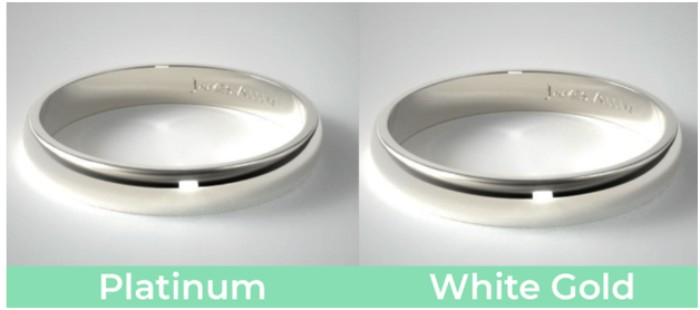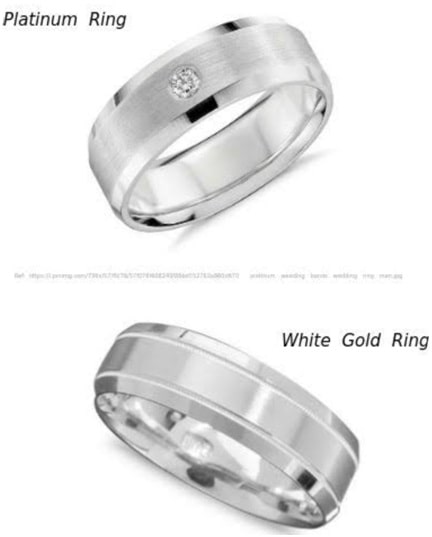
Between white gold vs platinum, which makes an ideal wedding metal band? That’s a common question that jewelers face from their clients. These two are almost similar in appearance, but they are different in materials and properties. Your design choice will play a significant role while determining the type of metal setting that will suit your jewelry pairing.
Both platinum and white gold have their pros and cons, which you need first to know to decide which outweighs the other. It also makes it easier for you to determine which of these you can incorporate in your jewelry design.
White gold vs. platinum, which one should you choose?
How durable are they? Both of these metals are strong and long-lasting. However, they respond to scratches and pressure differently.
Platinum
Platinum is quite a resistant metal and doesn’t wear out. It is a wedding ring preference for many couples because it barely loses its thickness even after wearing it for decades. Platinum’s flipside is it tends to lose its high polish and sharp edges so fast. Ouch, this might lead to some bruises or dents on the metal that leads to a patina. And that is a characteristic worth noting when comparing white gold vs platinum.
The pros of platinum:
- Platinum is a hypoallergenic metal- suitable for those who are prone to allergies.
- A symbol of prestige- buying an engagement for your partner is one of the significant milestones, and you want her to feel unique. Right?
- Rarer than white gold-people like something that is not very common.
- Long-lasting and way heavier than white gold.
The cons of platinum
- It is 40-50 percent more expensive than white gold. It scratches and turns dullish over time.
- Requires regular cleaning and polishing, after some years, which tend to strip away the metal.
- The upkeep of platinum is high since it requires regular polishing to maintain its smooth appearance.
White gold
White gold is a gorgeous metal mixture of other alloys and has a classic appearance. It has been a stunning choice for engagement rings since it cost less than platinum, although they are almost similar. Although it is not as thick as platinum, it is nearly strong. It can retain personalization like engraving better than platinum. One of its downsides is that it’s prone to wear, which results in thin metal overtime.
Based on the details above, it will be easy to choose between white gold vs platinum, depending on your lifestyle and career.
Which metal is affordable?
While white gold may be affordable than platinum, you may want to consider the maintenance cost.
Replating white gold can be more expensive than polishing platinum after a few years. If you select a platinum setting for your engagement ring, a simple solitaire should cost you anything from $300, while a vintage would go up to $3000. Factors like the amount of platinum used, ring, style, and the jeweler play a significant role in determining the platinum ring’s price.
White gold’s value depends on the karat and amount of metal used to create the ring. White gold ring with a simple solitaire should range from $180, and for a vintage ring setting, $2,500. The style you choose and the vendor are also factors that determine the final price. Since platinum is dense, it requires more platinum to make a ring than white gold. And that’s what raises the price of a platinum ring, then white gold.
Appearance
Platinum has a natural greyish/whitish color. In contrast, gold has a combination of alloy metals such as Palladium, nickel, pure gold, and a Rhodium plating to retain its white color. Regular dipping of Rhodium is required to maintain its color. As it wears out, a reapplication of this plating continues throughout the years. It can retain its beauty for up to 3 years when taken care of by the wearer.

You can hardly notice the color difference between platinum and white gold with your naked eye. Take a look here; white gold vs platinum.
White gold vs platinum composition
The white gold composition consists of pure gold mixed with other metals such as zinc, copper, nickel, and rhodium plating to keep it whiter. The gold in an 18 Karat jewelry is 75 percent gold, while a 14 Karat has 58.3 percent.
In comparison, platinum jewelry consists of 95-98 pure platinum, while the remaining metal is silver and Rhodium. Platinum is more robust, denser, and durable than white gold. As you can see, white gold depends on the percentage of other components for its strength and durability.
The pros of white gold:
- White gold affordability is more appealing than platinum.
- Contemporary and most preferred by millennials.
- A mix of other alloys makes it more robust, scratch-resistant, and durable.
- Many say it complements white diamonds better than yellow gold.
- Best complements those with fair skin or rosy tone.
The cons of white gold:
- It needs to be re-polished and re-plated by dipping it in Rhodium after every few years. It helps to retain its white color and luster. However, it’s not expensive, and some jewelers offer it for free.
- Other alloy metals mixed in white gold, such as nickel, may cause an allergic reaction for some people. The same is unlikely to happen for platinum since it’s hypoallergenic unless there’s nickel inclusion.
NB: One of the generous tips while choosing between white gold vs platinum is to consider pairing the engagement ring and wedding ring. You don’t want to have a mismatch but perfect coordination. When you stick to the same metal, you avoid rubbing one against the other harshly.
In conclusion, thanks for journeying with us. Now you know the secrets and understand the significant difference between these two metals. It should be a straightforward decision while choosing between white gold vs platinum, as you are more enlightened by this article. Right? Good luck!
